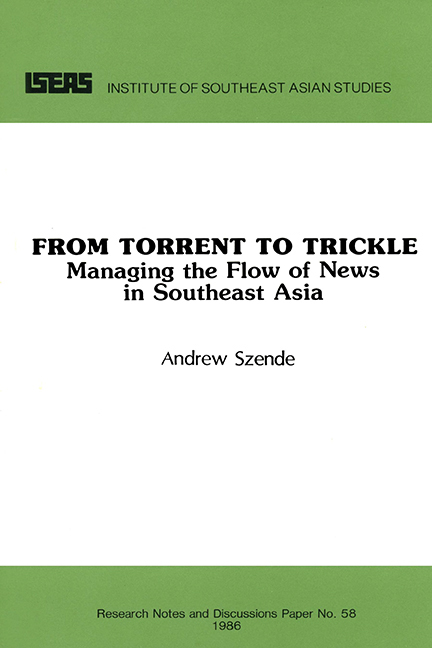VIII - Conclusions about the News Flow in ASEAN
from PART 3 - CONCLUSION
Published online by Cambridge University Press: 21 October 2015
Summary
Politically and economically the ASEAN organization has so far succeeded in keeping one foot in the Third World and the other foot in the developed western world. Over the first 15 years of the association's existence, it has remained faithful to the developing world, sometimes even acting as spokesman for the newly emerging nations in such gatherings as the United Nations General Assembly and the non-aligned movement. At the same time, it has moved closer to the industrialized world, through economic relations as well as a series of unique dialogue relationships with the European Community, Japan, the United States, Australia, New Zealand and Canada. This continuing relationship with both the most powerful western industrialized countries and the developing world testifies to the region's desire to bridge the gap between those two worlds. Without forgetting their own colonial past or losing sight of their aspirations for developing strong, new and prosperous nations, ASEAN countries have also espoused some of the basic assumptions and ideology of the non-communist industrialized world. They are staunch believers in free enterprise and are equally staunch opponents of communism with the professed hope of turning their region into a Zone of Peace, Freedom and Neutrality.
Likewise, the debate over news in the ASEAN region mirrors this political situation, as news professionals are caught between the powerful currents of news flowing from the industrialized world and the demands for balanced flow from the developing world. This study attempted to assess how the political issues raised by the MacBride Commission report concerning the relationship of the press and governments, concerning the conflict between the free flow and the balanced flow of news and concerning the conflict between western news values and developmental news values, apply to this region. The study also attempted to test the contention raised in the MacBride report that government control provides improved news coverage or results in a more balanced flow of news and to test the report's assertion that regional co-operation in news circulation results in improved news coverage.
- Type
- Chapter
- Information
- From Torrent to TrickleManaging the Flow of News in Southeast Asia, pp. 95 - 101Publisher: ISEAS–Yusof Ishak InstitutePrint publication year: 1986

